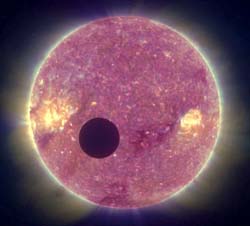
In this alien-looking scene, captured on February 25th by STEREO B, the Moon appears in silhouette against the Sun's face. Bright areas in this extreme-ultraviolet composite mark hot spots on the solar chromosphere. Click on the image for a larger view.
NASA
What started out as a simple calibration test on a new spacecraft has yielded a remarkable view of the Moon crossing the Sun's face — one not possible to glimpse from Earth.
STEREO B, launched last October, is in a solar orbit and, for now, trails Earth in space by about 1 million miles. Mission scientists knew that on February 25th the Moon would pass directly between the spacecraft and the Sun, providing a perfect opportunity to measure a characteristic called "dark current" in some of the craft's electronic cameras.
However, from STEREO B's current location the Moon has about one-fourth the apparent size seen from Earth. So rather than eclipsing the Sun completely, the smaller-than-usual Moon appeared as a striking black disk transiting the solar face. The entire transit can be viewed as Quicktime and MPEG videos available from the STEREO website.
The view seen here shows the Sun's disk as a composite of four extreme-ultraviolet wavelengths that isolate emissions from ionized helium and iron in the Sun's chromosphere and lower corona.
Over the next two years, two nearly identical spacecraft — "A" positioned ahead of Earth in its orbit, "B" trailing behind — will provide the first-ever stereoscopic measurements to study the Sun and the nature of its powerful coronal mass ejections, or CMEs. STEREO, which stands for Solar TErrestrial RElations Observatory, is the third mission in NASA's Solar Terrestrial Probes program (STP).
 0
0
Comments
You must be logged in to post a comment.